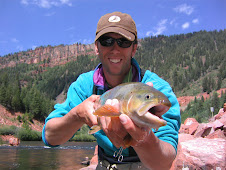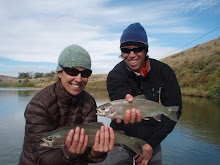 A spring road trip through southern CO and NM always affords the angler a chance to fish quality water. This particular trip found me meeting with some great Patagonia Fish accounts and spending some time with the folks that make them the great places they are.
A spring road trip through southern CO and NM always affords the angler a chance to fish quality water. This particular trip found me meeting with some great Patagonia Fish accounts and spending some time with the folks that make them the great places they are.Jon Harp of the Conejos River Anglers was kind enough to take me on a quick tour of that storied fishery. If you have never had an opportunity to walk the land and water of that canyon, make a plan to do so. "Spectacular" does not do it justice. Although the water was running closer to chocolate milk, the company and scenery more than made up for it. Jon has done an incredible job with the Superfly event and the potential for some amazing river habitat improvements over the next few years is quickly becoming reality. Kudos to all the staff there.
 From there it was off to the San Juan to meet with Larry Johnson and Leslie Jedrey who operate the Soaring Eagle Lodge. Short story - get there. Great company, excellent guide staff, productive private water and fantastic meals are just the tip of the iceberg. The fabled waters of the SJ produced many a hungry rainbow and brown trout, and the unique nature of the fishery demanded a diverse skill set and patience.
From there it was off to the San Juan to meet with Larry Johnson and Leslie Jedrey who operate the Soaring Eagle Lodge. Short story - get there. Great company, excellent guide staff, productive private water and fantastic meals are just the tip of the iceberg. The fabled waters of the SJ produced many a hungry rainbow and brown trout, and the unique nature of the fishery demanded a diverse skill set and patience.To top it all off, there is no better chance to drill professional guides on Patagonia gear. Even I got to put some products I had not used to the test including the Stormfront Pack, the Hip Chest Pack and the new Guidewater Waders. Make no mistake - the water of the San Juan never really warms up and merino-lined booties make and 8-hour day of wading plenty comfy. As always, the Great Divider stands out as the premier drift boat bag. I got to row Larry's Clackacraft (exactly the same as my boat which made it easy...) one day and the GD keeps everything where you need it and dry to boot.
 Thanks to everyone for your hospitality, local knowledge and dedication to the Patagonia brand. I have to give a special bonus award to Larry and Leslie - waking up every morning to the Red Sox scores outside the fly shop was just sensational - the fact they swept the Yankees series boded well for tight lines on the water!
Thanks to everyone for your hospitality, local knowledge and dedication to the Patagonia brand. I have to give a special bonus award to Larry and Leslie - waking up every morning to the Red Sox scores outside the fly shop was just sensational - the fact they swept the Yankees series boded well for tight lines on the water!
















